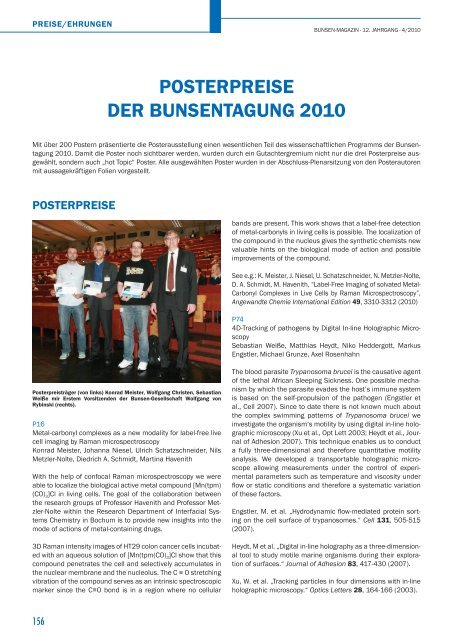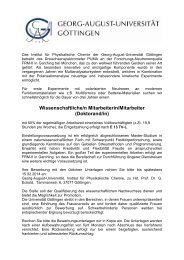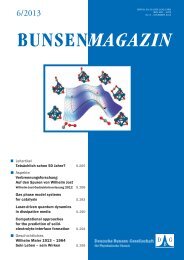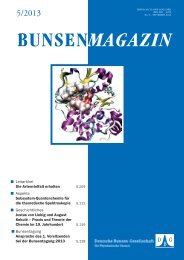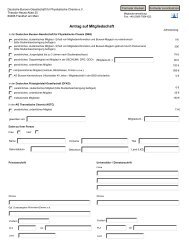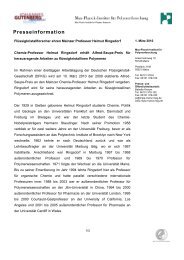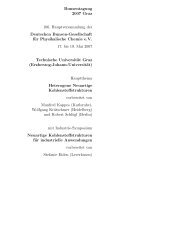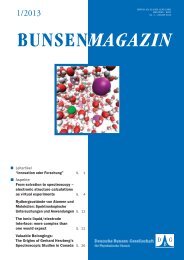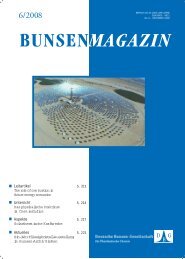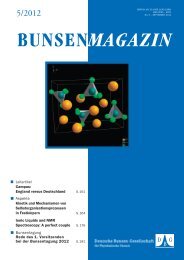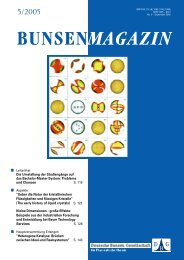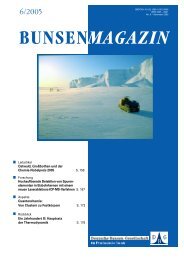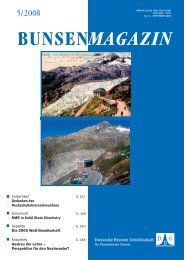BuMa_2010_04 - Deutsche Bunsengesellschaft für Physikalische ...
BuMa_2010_04 - Deutsche Bunsengesellschaft für Physikalische ...
BuMa_2010_04 - Deutsche Bunsengesellschaft für Physikalische ...
Sie wollen auch ein ePaper? Erhöhen Sie die Reichweite Ihrer Titel.
YUMPU macht aus Druck-PDFs automatisch weboptimierte ePaper, die Google liebt.
PREISE/EHRUNGEN<br />
156<br />
POSTERPREISE<br />
DER BUNSENTAGUNG <strong>2010</strong><br />
BUNSEN-MAGAZIN · 12. JAHRGANG · 4/<strong>2010</strong><br />
Mit über 200 Postern präsentierte die Posterausstellung einen wesentlichen Teil des wissenschaftlichen Programms der Bunsentagung<br />
<strong>2010</strong>. Damit die Poster noch sichtbarer werden, wurden durch ein Gutachtergremium nicht nur die drei Posterpreise ausgewählt,<br />
sondern auch „hot Topic“ Poster. Alle ausgewählten Poster wurden in der Abschluss-Plenarsitzung von den Posterautoren<br />
mit aussagekräftigen Folien vorgestellt.<br />
POSTERPREISE<br />
Posterpreisträger (von links) Konrad Meister, Wolfgang Christen, Sebastian<br />
Weiße mir Erstem Vorsitzenden der Bunsen-Gesellschaft Wolfgang von<br />
Rybinski (rechts).<br />
P16<br />
Metal-carbonyl complexes as a new modality for label-free live<br />
cell imaging by Raman microspectroscopy<br />
Konrad Meister, Johanna Niesel, Ulrich Schatzschneider, Nils<br />
Metzler-Nolte, Diedrich A. Schmidt, Martina Havenith<br />
With the help of confocal Raman microspectroscopy we were<br />
able to localize the biological active metal compound [Mn(tpm)<br />
(CO) 3]Cl in living cells. The goal of the collaboration between<br />
the research groups of Professor Havenith and Professor Metzler-Nolte<br />
within the Research Department of Interfacial Systems<br />
Chemistry in Bochum is to provide new insights into the<br />
mode of actions of metal-containing drugs.<br />
3D Raman intensity images of HT29 colon cancer cells incubated<br />
with an aqueous solution of [Mn(tpm(CO) 3]Cl show that this<br />
compound penetrates the cell and selectively accumulates in<br />
the nuclear membrane and the nucleolus. The C ≡ O stretching<br />
vibration of the compound serves as an intrinsic spectroscopic<br />
marker since the C≡O bond is in a region where no cellular<br />
bands are present. This work shows that a label-free detection<br />
of metal-carbonyls in living cells is possible. The localization of<br />
the compound in the nucleus gives the synthetic chemists new<br />
valuable hints on the biological mode of action and possible<br />
improvements of the compound.<br />
See e .g.: K. Meister, J. Niesel, U. Schatzschneider, N. Metzler-Nolte,<br />
D. A. Schmidt, M. Havenith, “Label-Free Imaging of solvated Metal-<br />
Carbonyl Complexes in Live Cells by Raman Microspectroscopy”,<br />
Angewandte Chemie International Edition 49, 3310-3312 (<strong>2010</strong>)<br />
P74<br />
4D-Tracking of pathogens by Digital In-line Holographic Microscopy<br />
Sebastian Weiße, Matthias Heydt, Niko Heddergott, Markus<br />
Engstler, Michael Grunze, Axel Rosenhahn<br />
The blood parasite Trypanosoma brucei is the causative agent<br />
of the lethal African Sleeping Sickness. One possible mechanism<br />
by which the parasite evades the host’s immune system<br />
is based on the self-propulsion of the pathogen (Engstler et<br />
al., Cell 2007). Since to date there is not known much about<br />
the complex swimming patterns of Trypanosoma brucei we<br />
investigate the organism‘s motility by using digital in-line holographic<br />
microscopy (Xu et al., Opt Lett 2003; Heydt et al., Journal<br />
of Adhesion 2007). This technique enables us to conduct<br />
a fully three-dimensional and therefore quantitative motility<br />
analysis. We developed a transportable holographic microscope<br />
allowing measurements under the control of experimental<br />
parameters such as temperature and viscosity under<br />
fl ow or static conditions and therefore a systematic variation<br />
of these factors.<br />
Engstler, M. et al. „Hydrodynamic fl ow-mediated protein sorting<br />
on the cell surface of trypanosomes.“ Cell 131, 505-515<br />
(2007).<br />
Heydt, M et al. „Digital in-line holography as a three-dimensional<br />
tool to study motile marine organisms during their exploration<br />
of surfaces.“ Journal of Adhesion 83, 417-430 (2007).<br />
Xu, W. et al. „Tracking particles in four dimensions with in-line<br />
holographic microscopy.“ Optics Letters 28, 164-166 (2003).


